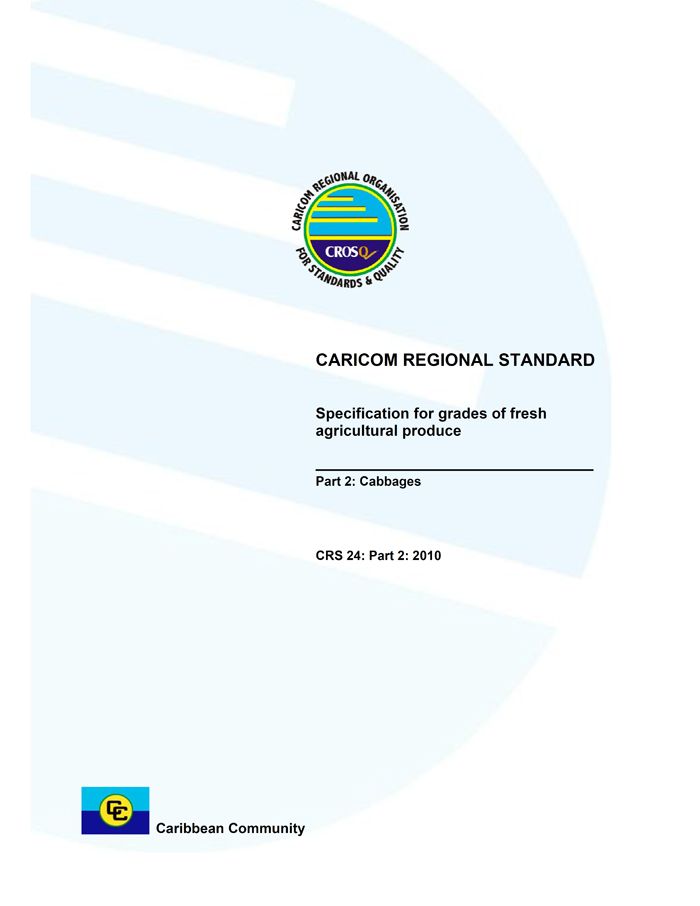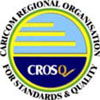
In order to promote public education and public safety, equal justice for all, a better informed citizenry, the rule of law, world trade and world peace, this legal document is hereby made available on a noncommercial basis, as it is the right of all humans to know and speak the laws that govern them.


CARICOM Regional Organisation for Standards and Quality (CROSQ)
2nd Floor Nicholas House
29 & 30 Broad Street
Bridgetown, St Michael
Barbados
T: 246.622.7670 | F: 246.622.7678
Website: http://www.crosq.org
© CROSQ 2010 – All rights reserved
Unless otherwise specified, no part of this publication may be reproduced or utilized in any form or by any means, electronic or mechanical, including photocopying and microfilm, without permission.
CRS 24: Part 2: 2010
CARICOM Regional Organisation for Standards and Quality (CROSQ)
2nd Floor, Nicholas House
29 & 30 Broad Street
Bridgetown, St. Michael
Barbados
T: 246.622.7670 | F: 246.622.7678
Website: http://www.crosq.org
© CROSQ 2010 – All rights reserved. No part of this publication is to be reproduced without the prior written consent of CROSQ.
ISBN 978-976-8234-04-9
ICS 67.080
| AMENDMENT NO. | DATE OF ISSUE | TYPE OF AMENDMENT | NO. OF TEXT AFFECTED | TEXT OF AMENDMENT |
|---|---|---|---|---|
This CARICOM Regional Standard was prepared under the supervision of the Regional Technical Committee for Agricultural Commodities (RTC 19), (hosted by the CARICOM Member State, Dominica), which at the time comprised the following members:
| Members | Representing |
|---|---|
| Mr. Lloyd Pascal (Chairperson) | Dominica Export Import Agency (DEXIA) |
| Mr. Richard Allport | Division of Agriculture, Dominica |
| Mr. Ryan Anselm | Plant protection and Quarantine Services, Dominica |
| Mr. Kent Coipel | Inter-American Institute for Cooperation on Agriculture (IICA) |
| Mr. Clement Ferreira | Nature’s Best, Dominica |
| Mrs. Marcella Harris | Windward Island Farmers Association (WINFA) |
| Mr. Cecil Joseph | Dominica Hucksters Association (1995) Ltd. (DHA) |
| Mr. Rawle Leslie | Dominica State College – Agriculture Faculty |
| Mr. Angus McIntyre | Windward Island Banana Development Cooperation (WIBDECO) |
| Dr. Gregory Robin, PhD | Caribbean Research and Development Institute (CARDI) |
| Mr. John Robin | Agro-Processors Association of Dominica (APAD) |
| Mr. Delroy Williams | National Association of Youth in Agriculture (NAYA), Dominica |
| Dr. Nadia Pacquette-Anselm (Technical Secretary) | Dominica Bureau of Standards |
| Foreword | 1 | |||
| 1 | Scope | 2 | ||
| 2 | Terms and definitions | 2 | ||
| 3 | Requirements | 3 | ||
| 3.1 | Quality | 3 | ||
| 3.1.1 | Minimum requirements | 3 | ||
| 3.1.2 | Classifications | 3 | ||
| 3.2 | Sizing | 4 | ||
| 3.3 | Tolerances | 4 | ||
| 3.3.1 | Quality tolerances | 4 | ||
| 3.3.2 | Size tolerance | 5 | ||
| 3.4 | Packaging | 5 | ||
| 3.5 | Labeling | 5 | ||
| 4 | Contaminants | 6 | ||
| 4.1 | Heavy metals | 6 | ||
| 4.2 | Pesticide residues | 6 | ||
| 5 | Hygiene and sanitation | 6 | ||
| List of tables | ||||
| Table 1 — Size of cabbage | 4 | |||
This CARICOM Regional Standard was developed in an effort to:
This standard was approved by the Twenty-ninth Council for Trade and Economic Development (COTED) on 8-9 February 2010.
In the development of this standard, assistance was derived from the following:
NOTE During the development of this standard, the CARICOM Regional Code of Practice for Food Hygiene was still under development.
1This standard applies to commercial varieties of cabbage (Brassica oleracea) to be supplied fresh to the consumer after preparation.
For the purposes of this standard, the following terms and definitions shall apply.
free from loose or adhering soil, pests, chemical deposits and other foreign matter
leaves are tightly formed with a firmness which is characteristic of the variety
defect or combination of defects of physiological or physical cause (external or internal) which detract from the appearance or edible quality of the cabbage such as holes caused by pests extending deeply into the compact portion or cuts and bruises that extend into the head
final point of official inspection prior to market
dense and not soft
free from any visible evidence of moulds, fungal and bacterial rots, spots or any symptom of viral infection
shape, colour, characteristics of the leaves and size typical of the variety
cabbage heads have no more than six (6) wrapper leaves and stems are no more than 10 mm below the wrapper leaves
cabbage heads are cut clean just below the lowest point of leaf growth with at least 3-5 tight wrapper leaves
2cabbage heads are compact and are at a stage of development suitable for good handling, and the quality meets the requirements of the market
thick leaves that do not enfold the head fairly tightly more than two-thirds the distance from the base to the top
Cabbages shall meet or exceed the following minimum requirements:
Cabbages shall be classified as Class I, Class II or Class III.
Cabbages in this class shall meet the minimum quality requirements in 3.1.1 and in addition shall be:
Cabbages in this class shall meet the minimum quality requirements in 3.1.1 and in addition shall be:
Cabbages in this class shall conform to the minimum quality requirements in 3.1.1 and in addition shall be:
Cabbages shall be sized according to the minimum and maximum weights of the individual cabbage head in kg.
| Size | Minimum kg |
Maximum kg |
|---|---|---|
| Small | 0.5 | 1.0 |
| Medium | 1.1 | 1.8 |
| Large | 1.9 | 2.5 |
| NOTE Size classification in each class may also be dependent on specific market requirements. | ||
Each package of cabbages not satisfying the requirements of quality and size for the class indicated as outlined in 3.1 and 3.2 shall be allowed tolerances as stated in 3.3.1 and 3.3.2.
Cabbages in this class shall meet the following requirements:
Cabbages in this class shall meet the following requirements:
Cabbages in this class shall meet the following requirements:
All classes shall be allowed a tolerance of 10 % by number or weight of cabbage corresponding to the size immediately below or above the size indicated on the package.
Cabbages shall be packed in such a way as to adequately protect the produce.
The materials used inside the package shall be new, clean and of a nature that shall meet the quality, hygiene, ventilation and resistance characteristics such as to avoid causing any external or internal damage to the produce.
NOTE The use of materials, particularly wrapping papers or adhesive labels bearing commercial indications, is allowed provided that the printing and labeling is done with a non-toxic ink or glue.
Packages shall be free from any foreign matter.
Each package of cabbage shall bear the following particulars in writing, legibly and indelibly marked and visible from the outside in the official language(s) of the country in which the produce is to be sold:
NOTE District where grown or national, regional or local name is optional.
NOTE 1 Net weight of package in kg is optional.
5NOTE 2 The use of red or orange should be avoided since these colours are used in the labeling of dangerous goods.
Cabbages shall comply with the maximum levels for heavy metals established by the CODEX Alimentarius Commission for this commodity.
Cabbages shall comply with the maximum pesticide residue limits established by the CODEX Alimentarius Commission for this commodity.
It is recommended that the produce covered by the provisions of this standard be prepared and handled in conjunction with the appropriate clauses of the latest edition of the CARICOM Regional Code of Practice for Food Hygiene or other international Codes of Practice, the latest recommended Code of Hygienic practices for Fresh Fruits and Vegetables (CAC/RCP 53-2003) and other Codex texts which are relevant to this commodity.
Cabbages shall comply with the microbiological criteria established in accordance with the Principles for the Establishment and Application of Microbiological Criteria for Foods (CAC/GL 271997).
Cabbages shall comply with Sanitary and Phyto-sanitary requirements of both the importing and exporting countries.
6
The CARICOM Regional Organisation for Standards and Quality (CROSQ) was created as an Inter-Governmental Organisation by the signing of an agreement among fourteen Member States of the Caribbean Community (CARICOM). CROSQ is the regional centre for promoting efficiency and competitive production in goods and services, through the process of standardization and the verification of quality. It is the successor to the Caribbean Common Market Standards Council (CCMSC), and supports the CARICOM mandate in the expansion of intra-regional and extra-regional trade in goods and services.
CROSQ is mandated to represent the interest of the region in international and hemispheric standards work, to promote the harmonization of metrology systems and standards, and to increase the pace of development of regional standards for the sustainable production of goods and services in the CARICOM Single Market and Economy (CSME), and the enhancement of social and economic development.
CROSQ VISION:
The premier CARICOM organisation for the development and promotion of an Internationally Recognised Regional Quality Infrastructure; and for international and regional harmonized CARICOM Metrology, Standards, Inspection, Testing and Quality Infrastructure
CROSQ MISSION:
The promotion and development of standards and standards related activities to facilitate international competitiveness and the sustainable production of goods and services within the CARICOM Single Market and Economy (CSME) for the enhancement of social and economic development
7 8